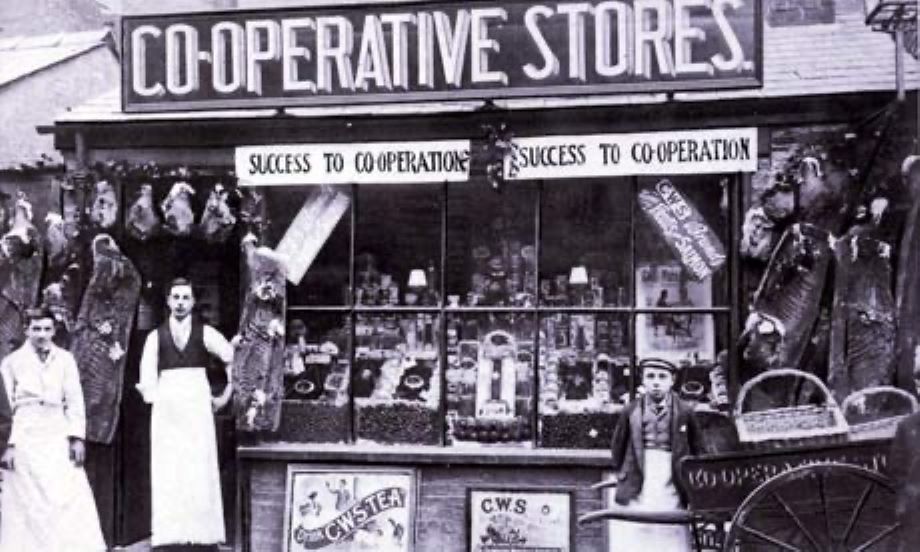
RAMYA SRIDHAR, DHOHA BARECHE – NOVEMBER 17TH, 2022
EDITOR: GRIFFIN SHUFELDT, SELINA YANG
PROJECT LEAD: SAM QUATTROCIOCCHI
The Cooperative Movement began in the 19th century as a response to the Industrial Revolution, protecting the rights, lives, and livelihoods of blue-collar workers from the harsh realities imposed on them. Cooperatives, also known as ‘co-ops’, were derivations of the older trade and social guilds that emerged during the Industrial Revolution to protect labor rights and frame cohesive communities. Contextually, the Industrial Revolution signified an era of change, even influencing the social, technological, environmental or economic dimensions of modern-day society. Within that impact, the existence and history of cooperatives remain an important milestone.
With the introduction of factories and mass production, scores of migrant workers shifted from rural to urban areas to capitalize on an expanding labor market. The middle-class artisan force in urban areas deteriorated as unskilled, blue collar workers rose to take their place. However, the jobs offered by these industries, while abundant, were menial and taxing, and often forced workers to sacrifice health and safety for low and often inadequate wages.
Cooperatives were first and formally introduced in the early 19th century in an effort to vocalize the struggles of the working class. Robert Owens (1771-1858), broadly regarded as the father of the Cooperative Movement, was a Welsh labor activist and a successful businessman who made his fortune as a textile manufacturer. Owens, motivated by the plights of laborers, considered the idea of independent communities composed of workers that were self-sufficient and self-governing, wherein members would have access to education and other mobilizing resources. While his attempts to implement these ideas ultimately failed, many of his arguments were used to form the core pillars of the Cooperative Movement. His ideas were later picked up by William King; in his magazine The Cooperator, he urged a more practical implementation of cooperatives to deal with poverty and economic grievances. Ultimately, this gave way to the formation of the Rochdale Pioneers.
Between 1830 and 1840, many attempted co-ops were formed and decisively failed and dissolved. However, in 1844, emerged the Rochdale Pioneers, a group of 28 cotton workers from the small town of Rochdale, who’d been facing poor working conditions and unfair wages. Together, they established the Rochdale Equitable Pioneers Society, which came to be considered the first modern cooperative business. The tenets of their community were regarded as the Rochdale Eight Principles, built upon the principles of democracy, professional ethics, and inclusivity. These became the footholds of the Cooperative Movement, and have been refined and adapted over time. They are broadly accepted as the defining features and code of cooperative society.
From the Rochdale Pioneers, many new and different cooperative societies began to emerge. One of the more popular co-op societies was the Knights of Labor, a labor federation based in America that was founded in 1869. The Order of the Patrons of Husbandry, also known as the Grange, was an agricultural cooperative, formed in America after the Civil War with the central aim of establishing direct and cost-efficient communications between producers and consumers. It was meant to provide a network of support and assistance to agriculturalists, while also cultivating awareness about farm work—its struggles and its misconceptions. The Patrons of Husbandry recognized that the farmer had long since been a poorly treated member of society, and sought to save them from exploitation and poverty. Despite weakening in the 1880s due to sparse membership and a poor business model, it established a much-needed connection between cooperative society and marginalized groups. Representation became a core aspect of the Cooperatives Movement. In 1883, the Women’s Co-op Guild, founded by Alice Acland, came into being, representing women workers and campaigning, among other things, for female suffrage. Just three years later, the Farmers’ Alliance opened up a division for black farmers who sought representation, known as the Colored Farmers’ National Alliance and Cooperative Union. However, as Jim Crow Laws appeared in the 1890s, it faced serious impediments to development.
Progressing along the timeline, the political presence of Cooperatives steadily rose. In 1917, in the UK, the Cooperative party was formed, providing parliamentary representation for cooperative societies. And in 1938, Congress passed the Fair Labor Standards Act, which limited the workweek to 44 hours. The legislation was reminiscent of Robert Owen’s original proposition—“Eight hours labor, eight hours recreation, eight hours rest.”
Following WW2, there was a great expansion of agricultural cooperatives, many of which originated from the 19th century. Small cooperatives formed in the 19th century in response to the difficult economic conditions farmers faced. Among these were the development of the first dairy and cheese cooperatives, which later evolved into major players. As a result of Westward expansion, the price of agricultural products went down, interest rates increased, and marketing margins widened.
The Federal Government increased funding for cooperatives after the Great Depression, through the New Deal, which established a banking system for agricultural cooperatives. However, its financial support was minimized after WW2. Even still, agricultural cooperatives continued to grow. This period saw the rise of a few larger cooperatives due to consolidation, characterized by business managerial leadership styles.
The 1960s and 1970s were notable for the rise of consumer cooperatives, owned and controlled by the people, that were influenced by the 1960s counterculture. An important aspect of these cooperatives was their commitment to social change. With the core value of representation, they played an important role in the Civil Rights Movement and in the development of the organic food industry. Black coops like the Federation of Southern Cooperatives not only supported Black rural farmers, but they were a vital form of resistance that helped expand Black land ownership, all starting with the first Farmers’ Alliance in 1868. Today, most coops serve people of color.
While agricultural cooperatives consist of farmers who work together as a single unit to support each other, consumer food cooperatives primarily serve people as a food distributive outlet. They were a form of social change and resistance, promoting intentional consumerism by making people more aware of where their food came from. In this spirit, food cooperatives supported movements like the Delano Grape Strike in the 1970s. It was through these cooperatives that organic food became popularized in mainstream grocery stories, during a time when the concept of organic food was being contested by the government and the agricultural sector.
Although many of these cooperatives failed due to insufficient capital, experimental operating strategies, and resistance to consolidations, those that survived are still in operation today. In fact, there are over 30,000 cooperatives today generating $660 billion in annual revenue, according to the U.S. Department of Agriculture’s October report. Cooperatives also employ 2 million people and have over 350 million memberships today.
Each era of cooperative development has had different goals for this new form of economic organization. Some have hoped it would replace capitalism, while the government has seen it as a useful corrective to market failure, according to author Craig Upright. Nonetheless, cooperatives have emerged at different times in history in response to economic, political and social concerns that weren’t being addressed, and they continue to fulfill the needs that are not being met by the market.
Featured Image Source: The Democracy Collaborative
Disclaimer: The views published in this journal, magazine, or website are those of the individual authors or speakers and do not necessarily reflect the position or policy of Berkeley Economic Review staff, the UC Berkeley Economics Department and faculty, or the University of California, Berkeley in general.



